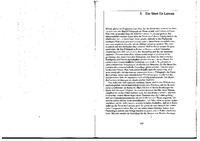A Word for LearningZu finden in:
|
 |
 Diese Seite wurde seit 12 Jahren inhaltlich nicht mehr aktualisiert.
Unter Umständen ist sie nicht mehr aktuell.
Diese Seite wurde seit 12 Jahren inhaltlich nicht mehr aktualisiert.
Unter Umständen ist sie nicht mehr aktuell.
 Zusammenfassungen
Zusammenfassungen

 In his paper, "A Word for Learning," Seymour Papert wonders why theories of teaching have received far more
attention than theories of learning, and he addresses the fundamental issues of what we mean by the word "learning."
He invites us to revisit our notions of learning through examining a personal experience. Using the example of learning
flower names, Papert illustrates two important aspects of learning: "The simple moral is that learning explodes when
you stay with it: A full year had passed before the effect in my mind reached a critical level for an exponential explosion
of growth. The more complex moral is that some domains of knowledge, such as plants, are especially rich in
connections and particularly prone to give rise to explosions of knowledge." The time to build personal connections is
an essential ingredient strikingly absent from most school learning situations.
In his paper, "A Word for Learning," Seymour Papert wonders why theories of teaching have received far more
attention than theories of learning, and he addresses the fundamental issues of what we mean by the word "learning."
He invites us to revisit our notions of learning through examining a personal experience. Using the example of learning
flower names, Papert illustrates two important aspects of learning: "The simple moral is that learning explodes when
you stay with it: A full year had passed before the effect in my mind reached a critical level for an exponential explosion
of growth. The more complex moral is that some domains of knowledge, such as plants, are especially rich in
connections and particularly prone to give rise to explosions of knowledge." The time to build personal connections is
an essential ingredient strikingly absent from most school learning situations. Dieser Text erwähnt ...
Dieser Text erwähnt ...
 Personen KB IB clear | G. Polya | ||||||||||||||||||
 Begriffe KB IB clear |  Denken Denken thinking
, thinking
,  Intelligenz Intelligenz intelligence
, intelligence
,  Kinder Kinder children
, children
,  LehrerIn LehrerIn teacher
, teacher
,  Lernen Lernen learning
, learning
,  Mathematik Mathematik mathematics
, Mathetik
, mathematics
, Mathetik
,  Mensch
, Mensch
,  Motivation Motivation motivation
, Pädagogik / Erziehungswissenschaft
, motivation
, Pädagogik / Erziehungswissenschaft
,  Schule Schule school
, school
,  Wissen Wissen
| ||||||||||||||||||
 Bücher |
|
 Dieser Text erwähnt vermutlich nicht ...
Dieser Text erwähnt vermutlich nicht ... 
 Nicht erwähnte Begriffe | Bildung, Digitalisierung, Eltern, Primarschule (1-6) / Grundschule (1-4), Schweiz, Unterricht, Wissensmanagement |
 Tagcloud
Tagcloud
 Zitationsgraph (Beta-Test mit vis.js)
Zitationsgraph (Beta-Test mit vis.js)
 Volltext dieses Dokuments
Volltext dieses Dokuments
 Anderswo suchen
Anderswo suchen 
 Beat und dieser Text
Beat und dieser Text
Beat hat Dieser Text während seiner Zeit am Institut für Medien und Schule (IMS) ins Biblionetz aufgenommen. Beat besitzt kein physisches, aber ein digitales Exemplar. (das er aber aus Urheberrechtsgründen nicht einfach weitergeben darf). Es gibt bisher nur wenige Objekte im Biblionetz, die dieses Werk zitieren.










 , 700 kByte)
, 700 kByte)  Biblionetz-History
Biblionetz-History